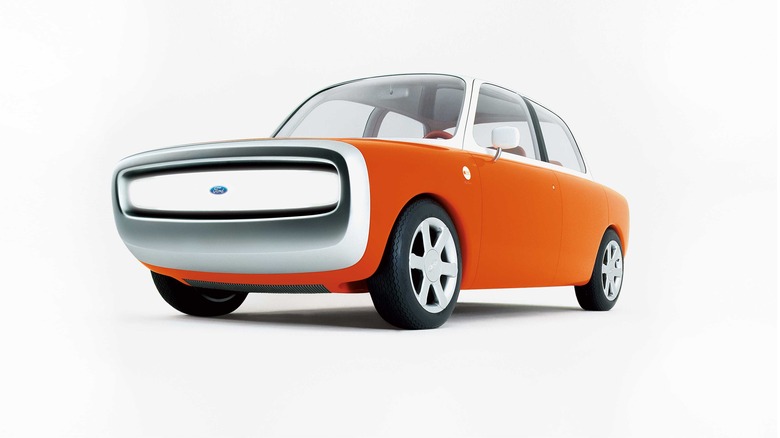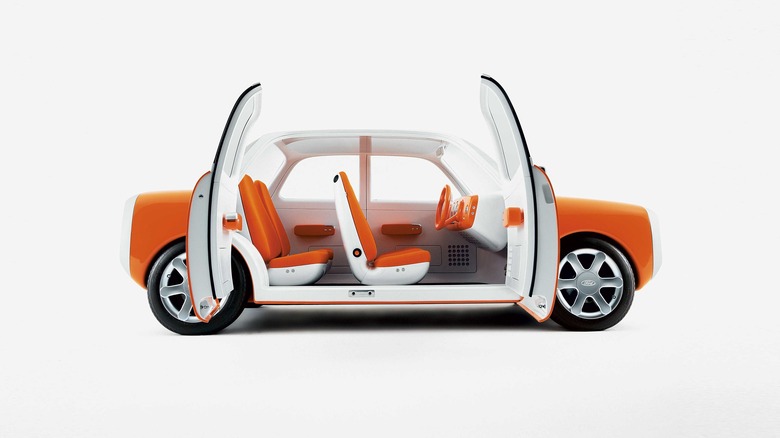This Ford Concept Car Made A Surprising Movie Cameo More Than 15 Years After It's Debut
There's something about the Ford 021C that doesn't seem quite real, and that's before you look inside and see the interior. It looks like one of the talking cars from the Chevron gasoline commercials, or a vehicle from a kid's animated movie.
But it is real: it was commissioned by an American automaker, designed by an Australian, and built in Italy. The boisterously bright colors and smooth rounded features have all the earmarks of an automobile made by Apple, or Disney. Ironically, the ties to those two iconic companies couldn't be more real either.
The 021C rolled into the 1999 Tokyo Motor Show and stole the spotlight, actually winning the "Best Concept Car Design" category. Furthermore, Ford openly admitted that this cartoon-like vehicle was created for one purpose: attract the kids. It wanted to get those "baby boomer juniors" not old enough to drive yet interested in cars at an early age. In fact, the "021C" designation stands for "buyers 21 and younger in the 21st Century" (via Motor Trend).
J Mays was Ford's chief car designer for 16 years, and during his tenure, he was the driving force behind the 021C's design. Mays tabbed that help of Australian furniture architect Marc Newson, who had never previously drawn up a car design. However, he was the guy who drafted the Apple Watch. The two tag-teamed the process and the end result was, as Newsom called it, a "retro-futurism" look (via Motor Trend).
This cartoonish car boasted exotic suicide doors
Newson wanted to "create a car that was light, likeable, and fun" that people could connect with emotionally. He added that it didn't have the typical design elements found in most cars, and utilized technology in practical ways (via Allcarindex.com).
Several collaborators built each piece of the completely carbon fiber 021C concept car from the ground up. For instance, Pirelli made the one-off custom tires (via Marc Newson). The wheels were fabricated in Canada, and the wool carpet from New Zealand was woven in Texas (via conceptcarz.com).
The trunk is reminiscent of a pull-out drawer on a modern refrigerator. With its minimalist instrument gauges, the "hovering" dashboard with a unique single-spoke steering wheel design moved up and down as a whole unit (via Marc Newson). The body-width, solo front "headlight" and rear "brake" light was made from a combination of programmable LEDs and a unique fiber optic system (via Tokyo Motor Show).
The pillarless cab featured conventional front doors and rear-hinged back doors that opened carriage style. Furthermore, the seats were mounted to the floorboard in such a way that they appear to be floating, and the front seats swiveled outwards (via Tokyo Motor Show). All the design elements created the illusion that there was far more space inside the cartoonish cockpit than there really was, as the 021C boasted the smallest interior of any other Ford vehicle at the time (via Marc Newson).
The real-life toy car that became a cartoon star
The diminutive ride was powered by Ford's 1.6-liter Zedec-SE engine, mated to a four-speed automatic transmission (via Tokyo Motor Show), and it was all put together at the historic Carrozzeria Ghia factory — now owned by Ford — in Turin, Italy (via Marc Newson).
Unfortunately, the 021C flopped in Tokyo. Perhaps it was the overt toy-like design, or Ford's public admission of going after underaged drivers (or both). Despite winning the "best design" award, the car did not win over many fans. However, it wouldn't be the last time we saw the peppy little car. Fast forward some 15 years ... re-enter J Mays.
Mays, who had long since moved on from the 021C, retired from Ford in January 2014. While at Ford, though, he had become friends with Pixar co-founder John Lasseter. Through that affiliation, he ended up working tangentially (and in later stages) as a consultant on a few Disney animated movies, including the first "Cars" film and "Big Hero 6" (via Jalopnik). When the Walt Disney Animation Studios began work on "Zootopia," Lasseter reached out to Mays and brought him on as the "chief car designer."
Mays job was to design all the cars, for the smallest field mouse to the tallest giraffe, and everything in between (via Jalopnik). And if you look closely at some of the scenes, you can catch a glimpse of that boisterous, bubbly 021C. This time, it was ripped straight from reality and dropped into a kid's animated movie.

